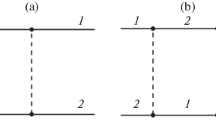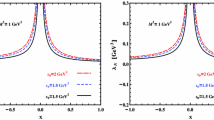Summary
The statistical nuclear model with exchange forces leads to a non-local interaction between a nucleon and its neighbours in nuclear matter (« Van Vleck-potential »). The implications of this interaction with regard to the modification of nuclear motion and to the energy dependence of the real parts of the optical model parameters are examined. Finally, a derivation of Van Vleck’s potential is given from Brueckner’s coherent model.
Riassunto
Il modello nucleare statistico con forze di scambio conduce a un’interazione non locale tra un nucleone e i suoi contigui nella materia nucleare (« potenziale di Van Vleck »). Si esaminano le conseguenze di questa interazione con riguardo alla modificazione del moto del nucleo e alla dipendenza dell’energia delle parti reali dei parametri del modello ottico. Finalmente si dà una derivazione del potenziale di Van Vleck a partire dal modello coerente di Brueckner.
Similar content being viewed by others
References
W. E. Frahn:Nuovo Cimento,4, 313 (1956), referred to as I.
K. A. Brueckner, C. A. Levinson andH. M. Mahmoud:Phys. Rev.,95, 217 (1954).
K. A. Brueckner:Phys. Rev.,96, 508 (1954).
K. A. Brueckner:Phys. Rev.,97, 1353 (1955).
K. A. Brueckner, R. J. Eden andN. C. Francis:Phys. Rev.,100, 891 (1955).
K. A. Brueckner:Phys. Rev.,103, 172 (1956).
J. H. van Vleck:Phys. Rev.,48, 367 (1935).
C. Fay:Phys. Rev.,50, 560 (1936).
J. Bardeen:Phys. Rev.,51, 799 (1937).
H. A. Bethe andR. F. Bacher:Rev. Mod. Phys.,8, 82 (1936).
E. Feenberg andJ. K. Knipp:Phys. Rev.,48, 906 (1935).
M. E. Johnson andE. Teller:Phys. Rev.,98, 783 (1955).
M. A. Melkanoff, S. A. Moszkowski, J. Nodvik andD. S. Saxon:Phys. Rev.,101, 507 (1956).
H. Feshbach, C. E. Porter andV. F. Weisskopf:Phys. Rev.,96, 448 (1954).
T. B. Taylor:Phys. Rev.,92, 831 (1953).
A. Kind andL. Jess:Nuovo Cimento,4, 595 (1956).
J. A. Wheeler:Phys. Rev.,50, 643 (1936).
W. J. Swiatecki:Phys. Rev.,101, 1321 (1956).
K. A. Brueckner andC. A. Levinson:Phys. Rev.,97, 1344 (1955).
Author information
Authors and Affiliations
Rights and permissions
About this article
Cite this article
Frahn, W.E. Nucleon-nucleus interaction from the statistical model. Nuovo Cim 5, 393–401 (1957). https://doi.org/10.1007/BF02855248
Received:
Published:
Issue Date:
DOI: https://doi.org/10.1007/BF02855248




